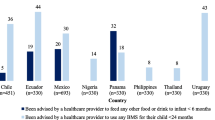Abstract
The aim of this study was to determine the compliance status of product labels regarding Article 9 of the International Code on Marketing of Breast-milk Substitutes (the Code) in Denizli province, Turkey. A cross-sectional study design was employed to determine the compliance status. The product labels were obtained from a convenience sample of five supermarkets, one store and 5 pharmacies in the City centre and district of Honaz. Using a data collection form prepared by previously published studies, data were collected between July 26, 2010 and August 06, 2010. Data collection form included 13 criteria. In addition, we checked the boxes for the availability of a Turkish written label. Forty product labels of 7 companies were reached and evaluated. These products consisted of 83.0% of the products marketed by these companies in Turkey. Thirty seven (92.5%) of the labels violated Article 9 of the Code in terms of one or more criteria. Thirty four (85.0%) of the labels had photos or pictures idealizing the use of infant formula. Nine (22.5%) had a photo, a picture or any representation of an infant, and five (12.5%) had text which idealize the use of infant formula or discouraging breastfeeding. Eight (20%) did not state that breastfeeding is the best. Four (10%) had a term such as ‘similar to breast milk or human milk’. In conclusion, the majority of the product labels of breast milk substitutes marketed in our country violate the Code. It is appropriate that the Turkish Ministry of Health, medical organizations, companies, and NGOs work more actively to increase awareness of this issue.
Similar content being viewed by others
References
WHO/UNICEF. (1989). Protecting, promoting and supporting breastfeeding. The special role of maternity services. Geneva: World Health Organization.
American Academy of Pediatrics. (1997). Work Group on Breastfeeding. Breastfeeding and the use of human milk. Pediatrics, 100:1035–1039.
US Department of Health and Human Services. (2000). HHS blueprint for action on breastfeeding. Washington, DC: US Department of Health and Human Services, Office on Women’s Health.
WHO/UNICEF. (2003). Global strategy for infant and young child feeding. Geneva, pp.7–8.
World Health Assembly Resolution WHA27.43. (1981). Handbook of resolutions and decisions of the world health assembly and the executive board, vol. II, 4th ed., Geneva, pp. 58.
WHO. World Health Assembly Resolution 33.32 infant and young child feeding. (1980). International code of marketing of breast-milk substitutes. Geneva.
WHO. (2011). International code of marketing of breast milk substitutes. http://www.who.int/nutrition/publications/code_english.pdf. Last accessed 1 Sept 2011.
IBFAN. Code and Resolutions and Code Essentials 3. (2011). Responsibilities of health workers under the international code of marketing of breastmilk substitutes and subsequent WHA resolutions. Penang. Downloaded from http://www.infactcanada.ca/wha-resolutions.html. Last accessed 1 Sept 2011.
Parrilla-Rodriguez, A. M., & Gorrin-Peralta, J. J. (2008). Formula labelling violations to the WHO code: A quantitative and qualitative analysis. Puerto Rico Health Sciences Journal, 27, 49–54.
International Baby Food Action Network. http://www.ibfan.org/. Last accessed 1 Sept 2011.
International Baby Food Action Network. (2007). Breaking the Rules. Stretching the Rules 2007: Evidence of violations of the international code of marketing of breast milk substitutes and subsequent resolutions. Penang: IBFAN S/B.
International Baby Food Action Network. (2010). Breaking the rules, stretching the rules. Executive summary. Downloaded from http://www.ibfan.org/icdc/. Last accessed 19 Jan 2012.
UNICEF. (2004). Compliance with the international code of marketing of breastmilk substitutes in Ukraine. Kyiv pp.14–22.
Aguayo, V., Ross, J. S., Kanon, S., & Ouedraogo, A. N. (2003). Monitoring compliance with the international code of marketing of breast milk substitutes in West Africa: Multisite cross sectional survey in Togo and Burkina Faso. British Medical Journal, 326, 127–131.
Mirzoeff, Nicholas. (2009). An introduction to visual culture. London, New York: Routledge.
Conflict of interest
The author(s) declared no potential conflicts of interest with respect to the research, authorship, and/or publication of this article.
Author information
Authors and Affiliations
Corresponding author
Rights and permissions
About this article
Cite this article
Ergin, A., Hatipoğlu, C., Bozkurt, A.İ. et al. Compliance Status of Product Labels to the International Code on Marketing of Breast Milk Substitutes. Matern Child Health J 17, 62–67 (2013). https://doi.org/10.1007/s10995-012-0971-5
Published:
Issue Date:
DOI: https://doi.org/10.1007/s10995-012-0971-5



